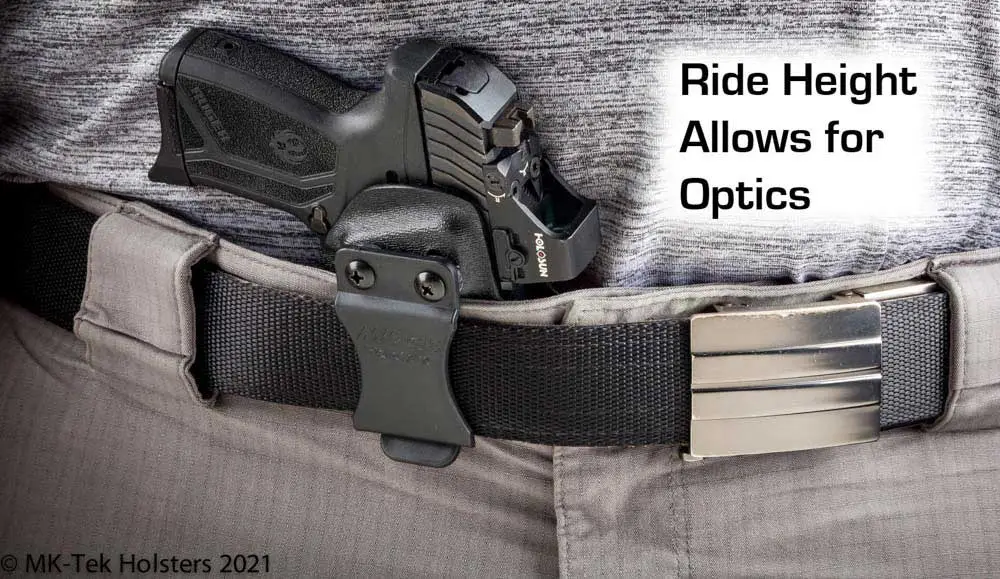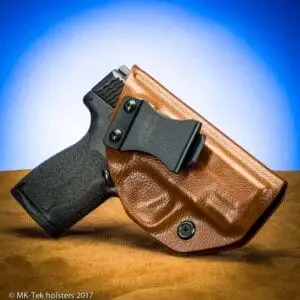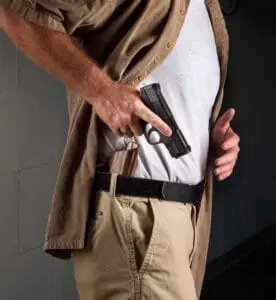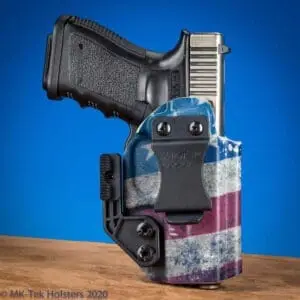Choosing the Best IWB Holster:
Practical Tips for Comfort and Concealment
Selecting the right inside-the-waistband (IWB) holster is about finding the right balance between comfort, concealment, and accessibility. For many concealed carriers, especially those who use MK-Tek Holsters, a well-fitted IWB holster offers a secure way to carry a firearm discreetly. Here’s how to make the most out of your IWB holster setup, plus some insider tips straight from our MK-Tek setup instructions page to get your holster dialed in just right. Concealed Carry Essentials for more info.
1. Why IWB Holsters are Popular for Concealed Carry
IWB holsters have gained popularity for concealed carry because they offer better concealment than other types of holsters. Unlike outside-the-waistband (OWB) holsters, IWB holsters rest between your waistband and body, minimizing the firearm’s visibility. This is ideal for everyday carry (EDC) since it allows you to conceal your firearm even with light clothing, providing a blend of discretion and readiness.
2. Understanding Cant and Ride Height: Keys to Comfort and Concealment
One of the first steps in setting up an IWB holster is adjusting the cant (the angle of the holster) and ride height (how high or low it sits in your waistband). Our setup instructions at MK-Tek Holsters emphasize these adjustments because they play a huge role in both comfort and draw efficiency.
- Cant: Adjusting the holster’s angle changes the ease of draw and concealment. Many users prefer a forward cant for better access and discreet positioning. Useful for Behind the Hip Carry. A Straight Cant or zero degree cant is designed for a straight draw such as when carrying at Appendix Carry.
- Ride Height: Setting a comfortable ride height affects how the holster feels when sitting or moving. A higher ride allows quicker access to the firearm but can be slightly more visible, while a lower ride improves concealment but may slightly slow the draw.
Both adjustments vary based on the wearer’s body type and preferences, and experimenting with these can help you find the sweet spot that balances comfort with accessibility.
3. Finding the Right Clip Position for Stability
The clip positioning on an IWB holster directly affects its stability and concealment. MK-Tek’s setup guide stresses that a strong clip and proper positioning reduce shifting or movement, especially during everyday activities like bending or sitting. Aligning the clip with the thickest part of your waistband, typically around the 3:30 to 4 o’clock position, can provide greater stability and maintain your holster’s position all day long. The Belt Clip needs to be able to engage with the belt for a proper structure. A thin belt with a larger belt clip lets the holster have “Free Play” when drawn.
Many users prefer belt clips with adjustable cant settings. MK-Tek Holsters provides several options to make finding a secure, comfortable setup easy. And if you’re unsure about positioning, start by aligning the holster just behind your hip bone for a natural fit and then test for comfort and access.
4. Retention and Safety: Ensuring the Firearm Stays Put
Retention, or how tightly the firearm is held in the holster, is another vital factor for safety and ease of draw. Our MK-Tek holsters come with adjustable retention screws that allow you to customize the tension to your needs, making sure your firearm stays put without unnecessary resistance when drawing.
MK-Tek designs its holsters to hold onto the firearm through the trigger guard, providing solid retention that doesn’t rely on friction against the gun’s surface. This is especially important as traditional friction-based systems can wear down over time. Regularly checking and adjusting retention, and even using a silicone spray to maintain smoothness, are practices that keep your IWB holster in top shape for a safe, reliable draw. Always double check your screws.
You can read more about Safety on this Blog Post about Safety.
5. Placement Options: Finding the Ideal Spot for Your Body Type
Your IWB holster’s placement can be just as important as its setup. Best IWB Holster setup carry positions include appendix (12:30 – 2 o’clock), behind the hip (3:30-4 o’clock), and small of the back (5-6 o’clock). Each has its benefits:
- Appendix Carry: Quick access and natural positioning, great for smaller firearms.
- Behind the Hip Carry: Popular for mid-sized firearms as it offers both comfort and concealment.
- Small of the Back Carry: Tends to be the most concealed position but may slow your draw slightly. There are other safety concerns with nerve pressure and drawing safely.
MK-Tek IWB holsters are designed to be versatile across these carry positions, allowing you to find a location that suits your comfort and accessibility needs. Many users start at the 3:30 o’clock position, adjusting based on the day’s activity level or clothing. We have Appendix Carried for over 40 years.
6. Holster Maintenance: Keep Your Setup in Optimal Condition
Finally, taking care of your IWB holster can ensure it remains comfortable and durable. Here are a few care tips from MK-Tek’s setup page:
- Regularly inspect retention screws to ensure they’re not loosening over time. Use Blue LokTite.
- Clean the holster interior periodically to remove any dust or buildup that could affect the draw.
- Apply silicone spray to maintain a smooth draw and reduce friction.
With these tips in mind, your holster will not only last longer but will also retain its shape and function, supporting your EDC setup for years to come.
Final Thoughts: Get the Most Out of Your IWB Holster with MK-Tek
Whether you’re new to concealed carry or a seasoned user, MK-Tek IWB holsters offer the flexibility, comfort, and security needed for everyday use. From adjusting cant and retention to selecting the right clip and placement, a little setup effort can make all the difference. So take your time to follow these tips, experiment with positioning, and make sure your holster setup fits your unique needs.
For more detailed setup instructions, check out our full guide on the MK-Tek setup page.





